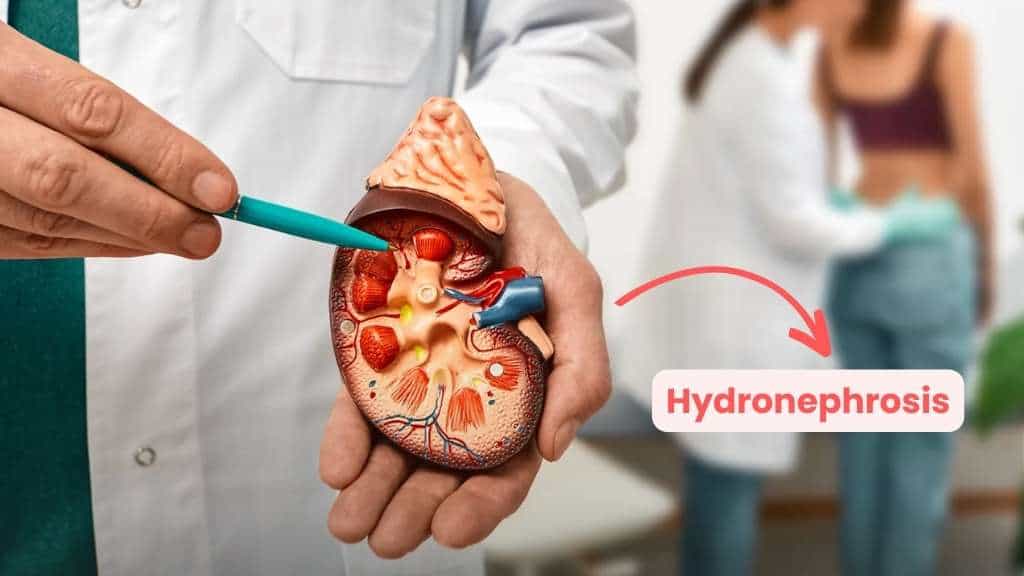
When urine does not correctly flow from the kidney to the bladder, it usually results in hydronephrosis, which causes the kidney to enlarge. One kidney is often affected, however, both might be affected.
It’s not a main illness, hydronephrosis. It is a secondary sickness that develops as a result of another underlying illness. Because of a blockage or obstruction in the urinary system, it is structural and causes pain. Approximately 1 in 100 infants are thought to have hydronephrosis.
The above briefly covers ‘what is hydronephrosis?’, further we will get into the depths of it.
What are the hydronephrosis symptoms?
Urine typically moves through the urinary system with little force. If the urinary system is obstructed, pressure may accumulate. Your kidney may expand if pee accumulates for a long time.
Urine engorgement in your kidney might cause it to begin pressing against adjacent organs. This pressure might permanently impair the function of your kidneys if it is not addressed in a timely manner.
Urinating more often and a stronger need to urinate are two mild signs of hydronephrosis. The following additional symptoms might be quite serious for you:
- nausea or abdominal or flank discomfort
- vomiting, discomfort when peeing, inability to completely empty the bladder or fever
Urinary tract infections (UTIs) are more likely to develop when urine flow is interrupted. UTIs are one of the most frequent side effects of hydronephrosis because of this.
Cloudy urine, back discomfort, bladder pain, a fever, and chills are all symptoms of painful urination.
Make an appointment with your doctor to discuss your symptoms if you see any hydronephrosis symptoms. Untreated UTIs can result in more severe illnesses including sepsis, a bloodstream infection, and pyelonephritis, an infection of the kidney.
How is hydronephrosis brought on?
An illness is not hydronephrosis. Instead, it could be brought on by internal and external ailments that have an impact on the urine-collecting system and the kidney.
Acute unilateral obstructive uropathy is one of the most typical causes of hydronephrosis. Your ureters, which are the tubes that link your kidneys to your bladder, suddenly developed a blockage.
A kidney stone is the most frequent reason for this obstruction, however scarring and blood clots may also be to blame.
Urine can back up into the kidney due to a blocked ureter, resulting in edema. The medical term for this urine backflow is vesicoureteral reflux (VUR).
The following are other obstruction causes:
An enlarged prostate gland in men, which can be caused by benign prostatic hyperplasia (BPH) or prostatitis, during pregnancy, which results in compression from the growing fetus, tumors in or near the ureter, a narrowing of the ureter as a result of an injury or birth defect
How is hydronephrosis identified?
It’s crucial to get a diagnosis as soon as possible. If your illness is not addressed in a timely manner, your kidneys may suffer irreparable damage.
Your doctor will likely start by evaluating your general health before concentrating on any urinary symptoms you may be experiencing. By gently stroking your abdominal and flank region, they can also be able to feel you expand your kidney.
Some of the pee in your bladder may be drained by your doctor using a catheter.
If they are unable to release a significant volume of pee in this manner, it may indicate that your urethra or bladder is the source of the obstruction. The urethra is a tube that connects your bladder to the exterior of your body and transports pee.
To examine the swelling more closely and perhaps pinpoint the location of the obstruction, your doctor may also order a renal ultrasound or CT scan.
Although both of these techniques provide your doctor with a picture of the interior of your body, the renal ultrasound is typically regarded as the most accurate way to identify hydronephrosis. It enables your doctor to examine your kidney more closely.
Conclusion; hydronephrosis treatment
The basic objective of hydronephrosis therapy is to get rid of whatever is impeding urine flow. Your doctor will decide on the best course of treatment for you based on the cause of your obstruction.
Your doctor may need to do any of the following if a clogged ureter is the root of your condition:
- To allow the ureter to drain into the bladder, a tube known as a ureteral stent has to be placed.
- The blocked urine should be drained via the back by inserting a nephrostomy tube.
- antibiotic usage in the treatment of infections
In order to remove the obstruction, your doctor might need to undergo surgery. If a blood clot or scar tissue is the cause of the blockage, your doctor may opt to completely remove the problematic area. They can then rejoin the healthy ends of your ureter to restore the regular flow of urine.
If a kidney stone is the root of your hydronephrosis, surgery may be necessary to remove it. To do this, your doctor may perform endoscopic surgery, which involves the use of tiny instruments. This greatly shortens the time it takes for you to heal and recover.
Your doctor could also suggest antibiotics. If you do this, you’ll be less likely to have a kidney infection.






